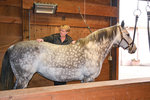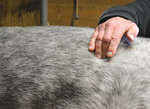

Lyn Dodd has been around horses as long as she can remember.
As a young girl growing up on her parents’ thoroughbred horse farm, Dodd developed a true passion for the art of horse breeding, racing and training. She won national and world horse riding medals, trained other riders, cared for her parents thoroughbreds and eventually found herself drawn into the world of holistic horse medicine.
By the age of 21, Dodd was working toward trying out for the Olympics and looking for an Olympic-caliber horse. Then, tragedy struck. Dodd’s beloved father, Charles, died unexpectedly and Dodd’s world was shattered.
“Everything went to hell after my father died,” Dodd says of that time in her life. “My world was upside down.”
When a relative, the founder of Horse Journal magazine who knew about holistic and alternative equine therapies, came to visit a grieving 22-year-old Dodd, the future suddenly seemed a little bit brighter.
“She had me do some healing work and said I was a natural,” Dodd says. “She encouraged me to go do this type of work.”
Flash forward nearly three decades and Dodd is now a certified Master Equine Body Worker who works in conjunction with veterinarians, farriers and other experts to holistically heal horses throughout the United States.
“I’ve had clients in Florida, Texas, California, Idaho, Oregon and Washington,” Dodd says. “Mainly, they hear about me through word of mouth … and I’ve been very lucky to find like-minded vets and farriers who work with me.”
Although her healing methods are dubbed “alternative,” Dodd says holistic equine healing works well with western veterinary medicine. In fact, she prefers to work with a horse’s vet to figure out the best course of action.
“Having worked with so many vets, I know a lot about my limitations,” Dodd says. “I’m not trying to replace the vet. I want to be an adjunct therapy.”
Most of Dodd’s equine clients suffer from sports-related injuries and tight muscles.
“They may have pulled themselves out of alignment,” Dodd says. “I work to restore balance in the horses.”
Sometimes, Dodd works with horses that have emotional problems. But even an emotional problem can often be helped through the manipulation of muscles and correction of an improper movement or out-of-whack alignment.
“A lot of horses, just by releasing the physical tensions in their bodies, they will go on to clear their emotional baggage,” Dodd says.
Dodd has added a battery of holistic modalities to her list of therapeutic techniques over the years, and can use the following to help heal horses, as well dogs:
Massage
Dodd uses a blend of massage techniques, including craniosacral and myofascial release, to help balance the horse’s (or dog’s) muscles, sometimes stretching a muscle and other times helping a muscle learn to contract. In an article she wrote for Holistic Horse magazine, Dodd says horses often direct her to areas of the body that need attention.
“By keeping an open mind and allowing the horse to participate in the process, it has been my experience that he will lead me to the most important areas,” Dodd states. “This is like the process of peeling an onion: Layer by layer. Sometimes you will get many layers with one movement, but mostly it is a layer at a time. Since most of these layers/patterns have been established over a long period, it is understandable that it will take some time to undo them.”
Myofascial release is a technique often employed in the treatment of human athletes and has shown to be very effective in treating the types of elite equine racers that Dodd often works with. The massage technique helps elongate foreshortened connective tissue and restore movement. Likewise, craniosacral massage, which uses a soft tough to release the tissues surrounding the central nervous system, is often used to release deep-seated tension and help relieve pain and improve health throughout the body.
Acupressure
Using the same pressure points and meridians employed in acupuncture, this technique allows healers to use their fingers instead of needles to stimulate the body’s natural healing mechanisms. Developed in Asia more than 5,000 years ago, acupressure is used to help relieve stress, boost the immune system, reduce tension and pain and increase blood circulation.
Saddle fit
Dodd uses the Fort Lewis Saddle Fit System, which uses a “playdough like” pad under the saddle to help find the places where the saddle is ill-fitting or placing stress on the horse. A custom orthotic saddle pad helps ease the horse’s pain and allows the rider to her everyday saddle without causing any further stress to the horse’s back, hips and legs.
Cold laser therapy
Using a high-power cold laser, Dodd is able to stimulate a horse’s tissue using specific wavelengths of light. The therapy helps brings blood to the area to reduce inflammation and help ease pain and tension. Cold laser therapy, which penetrates up to 5 centimeters beneath the skin to reach tissues below the dermis and epidermis, is used to eliminate pain, reduce swelling, control muscle spasms and speed the overall healing process.
Flower essences
Developed by a British physician in the 1930s to help treat emotional and mental wellness, flower essences are infusions or decoctions made from the flowering part of the plant. They have been known to treat human and animals with great success, and Dodd incorporates the flower essences into her treatment of horses and dogs.
“They work well for horses that are nervous or withdrawn or lashing out,” Dodd says of the flower essences. “They can be used in combos, usually with no more than six flower essences per combo … and usually I’ll put the essence in a spray bottle, so you can spray this on the horse’s feet or body, or put in your hand and have the horse lick it.”
Horses and dogs can also ingest the flower essences in their food or water, Dodd says, and she’s seen positive results spraying the essences on the horse’s saddle and in the horse’s living environment.
Microcurrent
This therapy uses a microcurrent machine to naturally mimic the horse’s muscle currents and can help with overall muscle issues or tendon issues, Dodd says.
Chi machine
The Chi machine uses chaotic sound waves to help sedate nervous horses and help them with other emotional issues.
Impact tool
Dodd uses this electronic tool to help reset nerve endings and increase blood flow, which helps alleviate pain and reduce inflammation.
No matter which modality Dodd uses on her equine and canine clients, she is always aware of the animal’s own unique needs and desires.
“I’m blessed that I’ve had the kind of life I’ve had,” Dodd says. “I’ve been around horses all my life … and the animals are so clear. I keep an open mind and let them show me what they need.”
Although she tends to work with elite race horses and high-level jumping or dressage horses, Dodd also loves working with regular, backyard riding horses. She can come to her client’s stables — unless they don’t have adequate facilities, then they are welcome to bring their horses to Dodd’s Ridgefield facilities. She also offers riding lessons to all levels of riders and can help beginning riders learn proper riding techniques, which in turn prevent future injuries to the horse.
“It all starts with having proper alignment,” Dodd says. “I just want to do what’s best for the horse.”
To find out more about Dodd and her holistic equine healing practice, Restoring Balance Equine Services in Ridgefield, email her at lynd@1791.com or call (360) 931-7914.